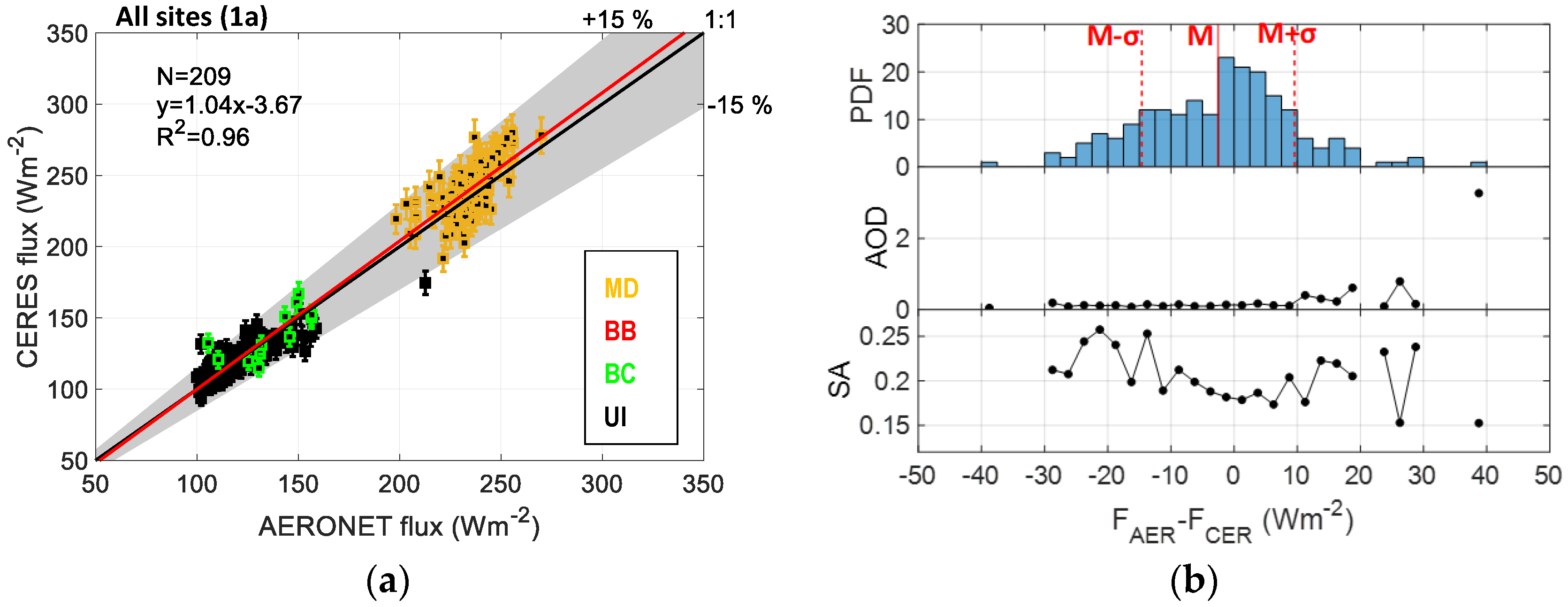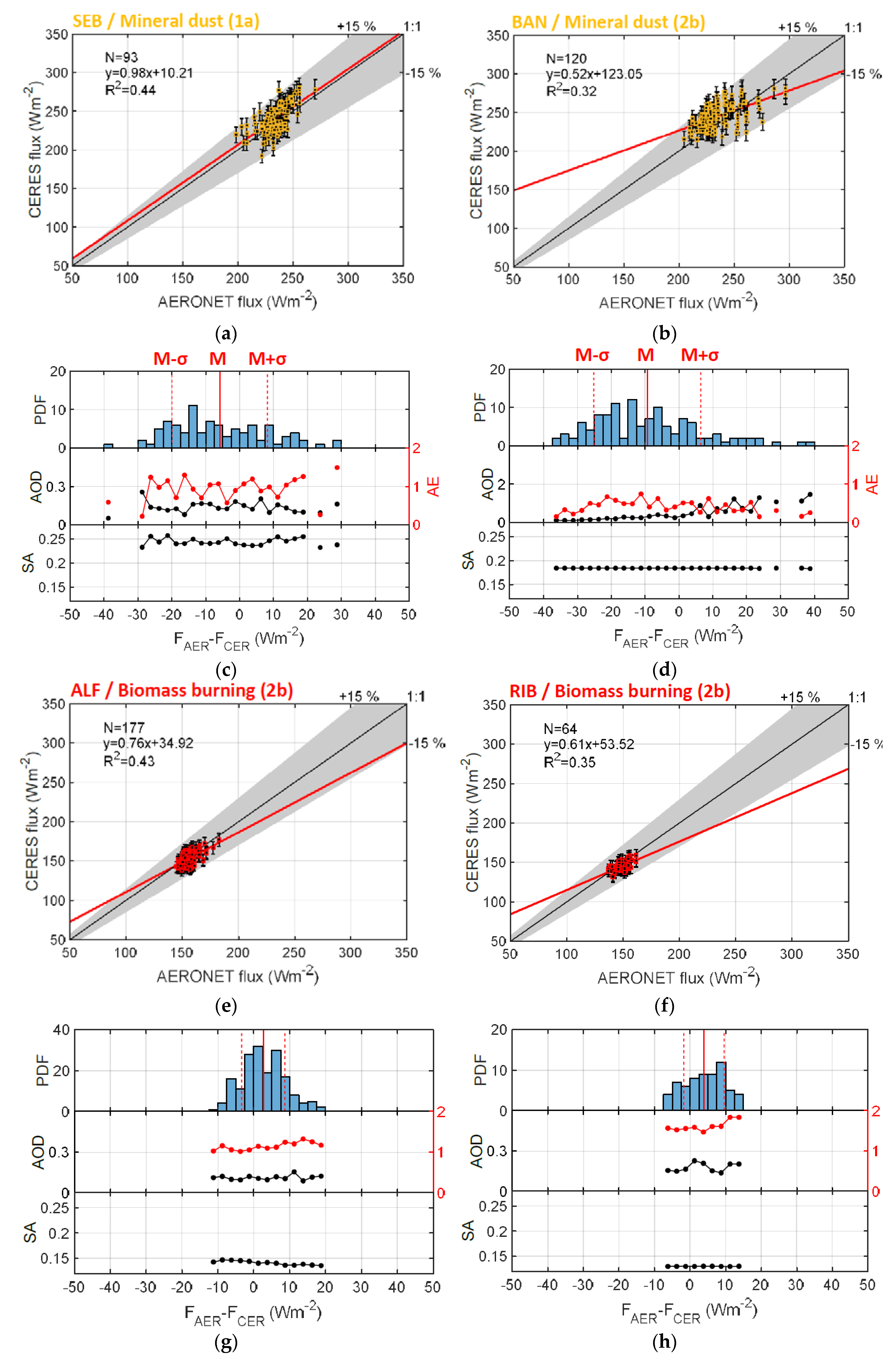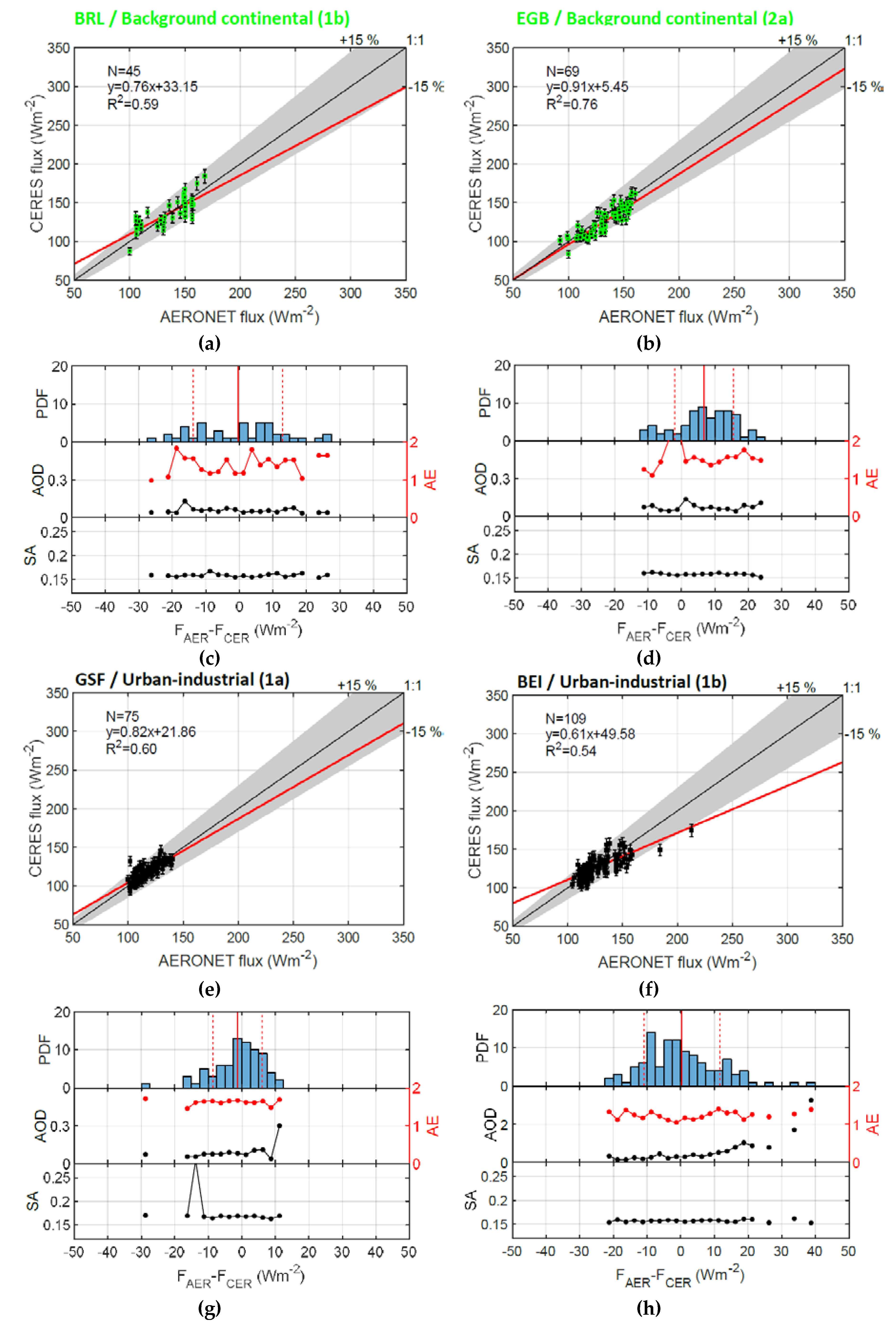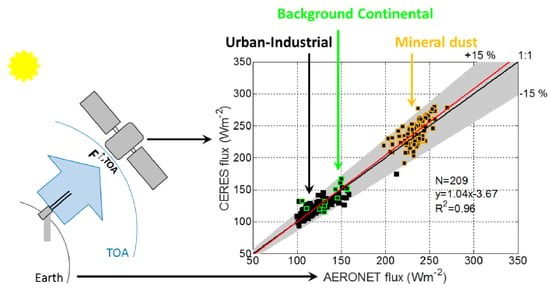Validation of AERONET-Estimated Upward Broadband Solar Fluxes at the Top-Of-The-Atmosphere with CERES Measurements
Abstract
1. Introduction
2. Materials and Methods
2.1. Instruments
2.1.1. AERONET
2.1.2. CERES
2.2. Strategy
2.2.1. Space-Time Co-Location Criteria
2.2.2. Corrections Applied
2.3. Selected Stations and Aerosol Types
3. Results and Discussion
3.1. AERONET Flux Validation at the TOA: All Sites, Criterion 1a
3.2. AERONET Flux Validation at the TOA: Site by Site Analysis
4. Conclusions
Funding
Acknowledgments
Conflicts of Interest
References
- Holben, B.N.; Eck, T.F.; Slutsker, I.; Tanre, D.; Buis, J.P.; Setzer, A.; Vermote, E.; Reagan, J.A.; Kaufman, Y.J.; Nakajima, T. AERONET—A federated instrument network and data archive for aerosol characterization. Remote Sens. Environ. 1998, 66, 1–16. [Google Scholar] [CrossRef]
- Giles, D.M.; Sinyuk, A.; Sorokin, M.G.; Schafer, J.S.; Smirnov, A.; Slutsker, I.; Eck, T.F.; Holben, B.N.; Lewis, J.R.; Campbell, J.R.; et al. Advancements in the Aerosol Robotic Network (AERONET) Version 3 database—Automated near-real-time quality control algorithm with improved cloud screening for Sun photometer aerosol optical depth (AOD) measurements. Atmos. Meas. Tech. 2019, 12, 169–209. [Google Scholar] [CrossRef]
- Derimian, Y.; Leon, J.F.; Dubovik, O.; Chiapello, I.; Tanré, D.; Sinyuk, A.; Auriol, F.; Podvin, T.; Brogniez, G.; Holben, B.N. Radiative properties of aerosol mixture observed during the dry season 2006 over M’Bour, Senegal (African Monsoon Multidisciplinary Analysis campaign). J. Geophys. Res. 2008, 113, D00C09. [Google Scholar] [CrossRef]
- García, O.E.; Díaz, A.M.; Expósito, F.J.; Díaz, J.P.; Dubovik, O.; Dubuisson, P.; Roger, J.C.; Eck, T.F.; Sinyuk, A.; Derimian, Y.; et al. Validation of AERONET estimates of atmospheric solar fluxes and aerosol radiative forcing by ground-based broadband measurements. J. Geophys. Res. 2008, 113, D21207. [Google Scholar] [CrossRef]
- Yoon, S.-C.; Won, J.-G. Evaluation of the aerosol direct radiative forcing out of the AERONET data. Óptica Pura y Aplicada 2004, 37, 3153–3158. [Google Scholar]
- Sicard, M.; Barragan, R.; Dulac, F.; Alados-Arboledas, L.; Mallet, M. Aerosol optical, microphysical and radiative properties at regional background insular sites in the western Mediterranean. Atmos. Chem. Phys. 2016, 16, 12177–12203. [Google Scholar] [CrossRef]
- Derimian, Y.; Dubovik, O.; Tanre, D.; Goloub, P.; Lapyonok, T.; Mortier, A. Optical properties and radiative forcing of the Eyjafjallajokull volcanic ash layer observed over Lille, France, in 2010. J. Geophys. Res. 2012, 117, D00U25. [Google Scholar] [CrossRef]
- AERONET Inversion Products (Version 3). Available online: https://aeronet.gsfc.nasa.gov/new_web/Documents/Inversion_products_for_V3.pdf (accessed on 12 July 2019).
- Sinyuk, A.; Dubovik, O.; Holben, B.; Eck, T.F.; Breon, F.M.; Martonchik, J.; Kahn, R.; Diner, D.J.; Vermote, E.F.; Roger, J.C.; et al. Simultaneous retrieval of aerosol and surface properties from a combination of AERONET and satellite data. Remote Sens. Environ. 2007, 107, 90–108. [Google Scholar] [CrossRef]
- Dubuisson, P.; Buriez, J.C.; Fouquart, Y. High spectral resolution solar radiative transfer in absorbing and scattering media: Application to the satellite simulation. J. Quant. Spectrosc. Ra. 1996, 55, 103–126. [Google Scholar] [CrossRef]
- Scott, N.A. A direct method of computation of the transmission function of an inhomogeneous gaseous medium-I: Description of the method. J. Quant. Spectros. Radiat. Transfer. 1974, 14, 691–704. [Google Scholar] [CrossRef]
- Smirnov, A.; Holben, B.N.; Dubovik, O.; Slutsker, I. Cloud screening and quality control algorithms for the AERONET data base. Remote Sens. Environ. 2000, 73, 73337–73349. [Google Scholar] [CrossRef]
- Wielicki, B.A.; Barkstrom, B.R.; Harrison, E.F.; Lee III, R.B.; Smith, G.L.; Cooper, J.E. Clouds and the Earth’s Radiant Energy System (CERES): An Earth Observing System Experiment. Bull. Amer. Meteor. Soc. 1996, 77, 853–868. [Google Scholar] [CrossRef]
- Loeb, N.G.; Kato, S.; Loukachine, K.; Smith, N.M. Angular distribution models for top-of-atmosphere radiative flux estimation from the Clouds and the Earth’s Radiant Energy System instrument on the Terra satellite: Part I. Methodology. J. Atmos. Ocean. Tech. 2005, 22, 338–351. [Google Scholar] [CrossRef]
- Kato, S.; Loeb, N.G. Top-of-atmosphere shortwave broadband observed radiance and estimated irradiance over polar regions from Clouds and the Earth’s Radiant Energy System (CERES) instruments on Terra. J. Geophys. Res. 2005, 110, D07202. [Google Scholar] [CrossRef]
- Su, W.; Corbett, J.; Eitzen, Z.A.; Liang, L. Next-Generation Angular Distribution Models for Top-of-Atmosphere Radiative Flux Calculation from the CERES Instruments: Methodology. Atmos. Meas. Tech. 2015, 8, 611–632. [Google Scholar] [CrossRef]
- Dubuisson, P.; Giraud, V.; Chomette, O.; Chepfer, H.; Pelon, J. Fast radiative transfer modeling for infrared imaging radiometry. J. Quant. Spectrosc. Ra. 2005, 95, 201–220. [Google Scholar] [CrossRef]
- Basart, S.; Pérez, C.; Cuevas, E.; Baldasano, J.M.; Gobbi, G.P. Aerosol characterization in Northern Africa, Northeastern Atlantic, Mediterranean Basin and Middle East from direct-sun AERONET observations. Atmos. Chem. Phys. 2009, 9, 8265–8282. [Google Scholar] [CrossRef]
- Gobbi, G.P.; Kaufman, Y.J.; Koren, I.; Eck, T.F. Classification of aerosol properties derived from AERONET direct sun data. Atmos. Chem. Phys. 2007, 7, 453–458. [Google Scholar] [CrossRef]
- Hoelzemann, J.J.; Longo, K.M.; Fonseca, R.M.; do Rosário, N.M.E.; Elbern, H.; Freitas, S.R.; Pires, C. Regional representativity of AERONET observation sites during the biomass burning season in South America determined by correlation studies with MODIS Aerosol Optical Depth. J. Geophys. Res. 2009, 114, D13301. [Google Scholar] [CrossRef]
- Sioris, C.E.; Abboud, I.; Fioletov, V.E.; McLinden, C.A. AEROCAN, the Canadian sub-network of AERONET: Aerosol monitoring and air quality applications. Atmos. Environ. 2017, 167, 444–457. [Google Scholar] [CrossRef]
- Chen, H.; Cheng, T.; Gu, X.; Li, Z.; Wu, Y. Characteristics of aerosols over Beijing and Kanpur derived from the AERONET dataset. Atmos. Poll. Res. 2016, 7, 162–169. [Google Scholar] [CrossRef]
- Gordon, H.R. Atmospheric correction of ocean color imaginary in the Earth Observing System era. J. Geophys. Res. 1997, 102, 17081–17102. [Google Scholar] [CrossRef]
- Torres, O.; Bhartia, P.K.; Sinyuk, A.; Welton, E.J.; Holben, B. Total Ozone Mapping Spectrometer measurements of aerosol absorption from space: Comparison to SAFARI 2000 ground-based observations. J. Geophys. Res. 2005, 110. [Google Scholar] [CrossRef]
- Hsu, N.C.; Tsay, S.C.; King, M.D.; Herman, J.R. Aerosol properties over bright-reflecting source regions. IEEE Trans. Geosci. Remote Sens. 2004, 42, 557–569. [Google Scholar] [CrossRef]
- Rutan, D.; Rose, F.; Roman, M.; Manalo-Smith, N.; Schaaf, C.; Charlock, T. Development and assessment of broadband surface albedo from Clouds and the Earth’s Radiant Energy System Clouds and Radiation Swath data product. J. Geophys. Res. 2009, 114, D08125. [Google Scholar] [CrossRef]
- Giles, D.M.; Holben, B.N.; Eck, T.F.; Sinyuk, A.; Smirnov, A.; Slutsker, I.; Dickerson, R.R.; Thompson, A.M.; Schafer, J.S. An analysis of AERONET aerosol absorption properties and classifications representative of aerosol source regions. J. Geophys. Res. 2012, 117, D17203. [Google Scholar] [CrossRef]





| Station | Acronym | Aerosol Type | V3L2.0 | Longitude | Latitude | Date Range | NAER |
|---|---|---|---|---|---|---|---|
| Sede Boker | SEB | MD | >15 y | 34.782E | 30.855N | 16/10/95–14/01/18 | 17005 |
| Banizombou | BAN | MD | >15 y | 2.655E | 13.547N | 17/10/95–07/07/18 | 9030 |
| Alta Floresta | ALF | BB | >10 y | 56.104W | 9.871S | 22/06/93–03/03/18 | 2904 |
| Rio Branco | RIB | BB | >7 y | 67.869W | 9.957S | 24/08/00–18/10/17 | 1628 |
| Bratts Lake | BRL | BC | >7 y | 104.713W | 50.204N | 22/06/97–06/11/12 | 2987 |
| Egbert | EGB | BC | >10 y | 79.781W | 44.232N | 03/09/97–29/05/18 | 4430 |
| GSFC | GSF | UI | >15 y | 76.840W | 38.992N | 27/05/93–05/03/18 | 11682 |
| Beijing | BEI | UI | >10 y | 116.381E | 39.977N | 09/03/01–04/06/18 | 4815 |
| Criterion | Restriction | Δt(min) | Δr(km) | SZA Correction | Cloud Coverage(%) |
|---|---|---|---|---|---|
| 1a | High + | ±5 | ±10 | No | >97 |
| 1b | High - | ±5 | ±20 | No | >97 |
| 2a | Medium + | ±60 | ±10 | Yes | >97 |
| 2b | Medium - | ±60 | ±20 | Yes | >97 |
| Station | Criterion | N | Overpass Time | Satellite | (º) | (º) | CF |
|---|---|---|---|---|---|---|---|
| SEB | 1a | 93 | Oct.–Feb. | All | 54.7 | 54.7 | - |
| BAN | 2b | 120 | Oct.–Feb. | Aqua | 46.2 | 55.9 | 1.103 |
| ALF | 2b | 177 | Apr.–Aug. | Aqua | 44.4 | 53.4 | 1.106 |
| RIB | 2b | 64 | May–Aug. | All | 45.2 | 53.9 | 1.108 |
| BRL | 1b | 45 | Sep.–Nov. | Terra, Aqua | 59.8 | 59.8 | - |
| EGB | 2a | 69 | Sep.-Jan.; Mar. | All; Terra, Aqua | 56.3 | 57.4 | 1.012 |
| GSF | 1a | 75 | Oct.-Mar. | All | 58.3 | 58.3 | - |
| BEI | 1b | 109 | Sep.-Mar. | All | 56.9 | 57.0 | - |
| Station | Slope ± σ | Bias ± σ (Wm−2) | RMSE (Wm−2) | R2 | Diff ± σ (Wm−2) | NormDiff ± σ (%) | Percentile 5,95 (Wm−2) |
|---|---|---|---|---|---|---|---|
| All (1a, N = 209) | 1.04 ± 0.01 | –3.67 ± 2.66 | 11.95 | 0.96 | –2.52 ±12.09 | –0.84 ± 6.74 | –22.76, 16.06 |
| SEB (1a, N = 93) | 0.98 ± 0.12 | 10.21 ± 26.86 | 14.16 | 0.44 | –5.87 ± 14.08 | –2.13 ± 5.98 | –24.35, 17.50 |
| BAN (2b, N = 120) | 0.52 ± 0.07 | 123.05 ± 16.43 | 13.38 | 0.32 | –9.37 ± 15.80 | –3.67 ± 6.36 | –31.62, 21.45 |
| ALF (2b, N = 177) | 0.76 ± 0.07 | 34.92 ± 10.29 | 5.80 | 0.43 | 2.67 ± 6.00 | 1.86 ± 3.99 | –7.04, 13.25 |
| RIB (2b, N = 64) | 0.61 ± 0.11 | 53.52 ± 16.01 | 5.21 | 0.35 | 3.91 ± 5.68 | 2.78 ± 3.99 | –5.36, 12.67 |
| BRL (1b, N = 45) | 0.76 ± 0.10 | 33.15 ± 13.35 | 12.64 | 0.59 | –0.41 ± 13.36 | 0.10 ± 10.04 | –21.38, 24.05 |
| EGB (2a, N = 69) | 0.91 ± 0.06 | 5.45 ± 8.30 | 8.68 | 0.76 | 6.76 ± 8.76 | 5.77 ± 7.39 | –9.40, 20.69 |
| GSF (1a, N = 75) | 0.82 ± 0.08 | 21.86 ± 9.24 | 7.16 | 0.60 | –1.27 ± 7.35 | –0.83 ± 6.00 | –15.35, 8.52 |
| BEI (1b, N = 109) | 0.61 ± 0.05 | 49.58 ± 6.99 | 9.32 | 0.54 | 0.37 ± 11.31 | 0.46 ± 8.47 | –17.39, 19.24 |
© 2019 by the author. Licensee MDPI, Basel, Switzerland. This article is an open access article distributed under the terms and conditions of the Creative Commons Attribution (CC BY) license (http://creativecommons.org/licenses/by/4.0/).
Share and Cite
Sicard, M. Validation of AERONET-Estimated Upward Broadband Solar Fluxes at the Top-Of-The-Atmosphere with CERES Measurements. Remote Sens. 2019, 11, 2168. https://doi.org/10.3390/rs11182168
Sicard M. Validation of AERONET-Estimated Upward Broadband Solar Fluxes at the Top-Of-The-Atmosphere with CERES Measurements. Remote Sensing. 2019; 11(18):2168. https://doi.org/10.3390/rs11182168
Chicago/Turabian StyleSicard, Michaël. 2019. "Validation of AERONET-Estimated Upward Broadband Solar Fluxes at the Top-Of-The-Atmosphere with CERES Measurements" Remote Sensing 11, no. 18: 2168. https://doi.org/10.3390/rs11182168
APA StyleSicard, M. (2019). Validation of AERONET-Estimated Upward Broadband Solar Fluxes at the Top-Of-The-Atmosphere with CERES Measurements. Remote Sensing, 11(18), 2168. https://doi.org/10.3390/rs11182168






